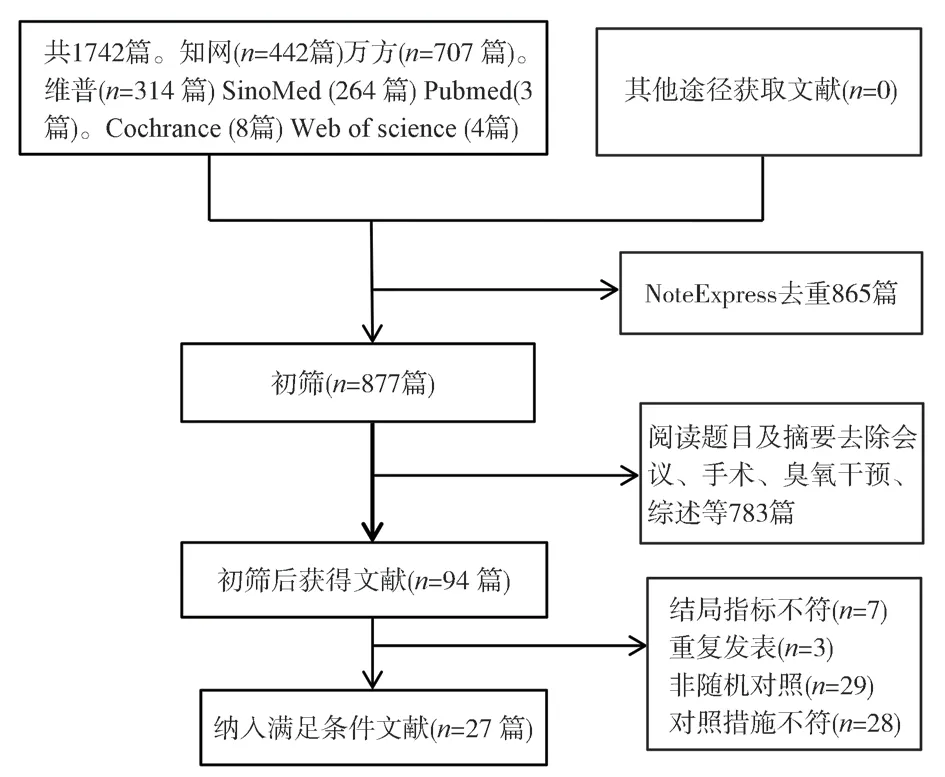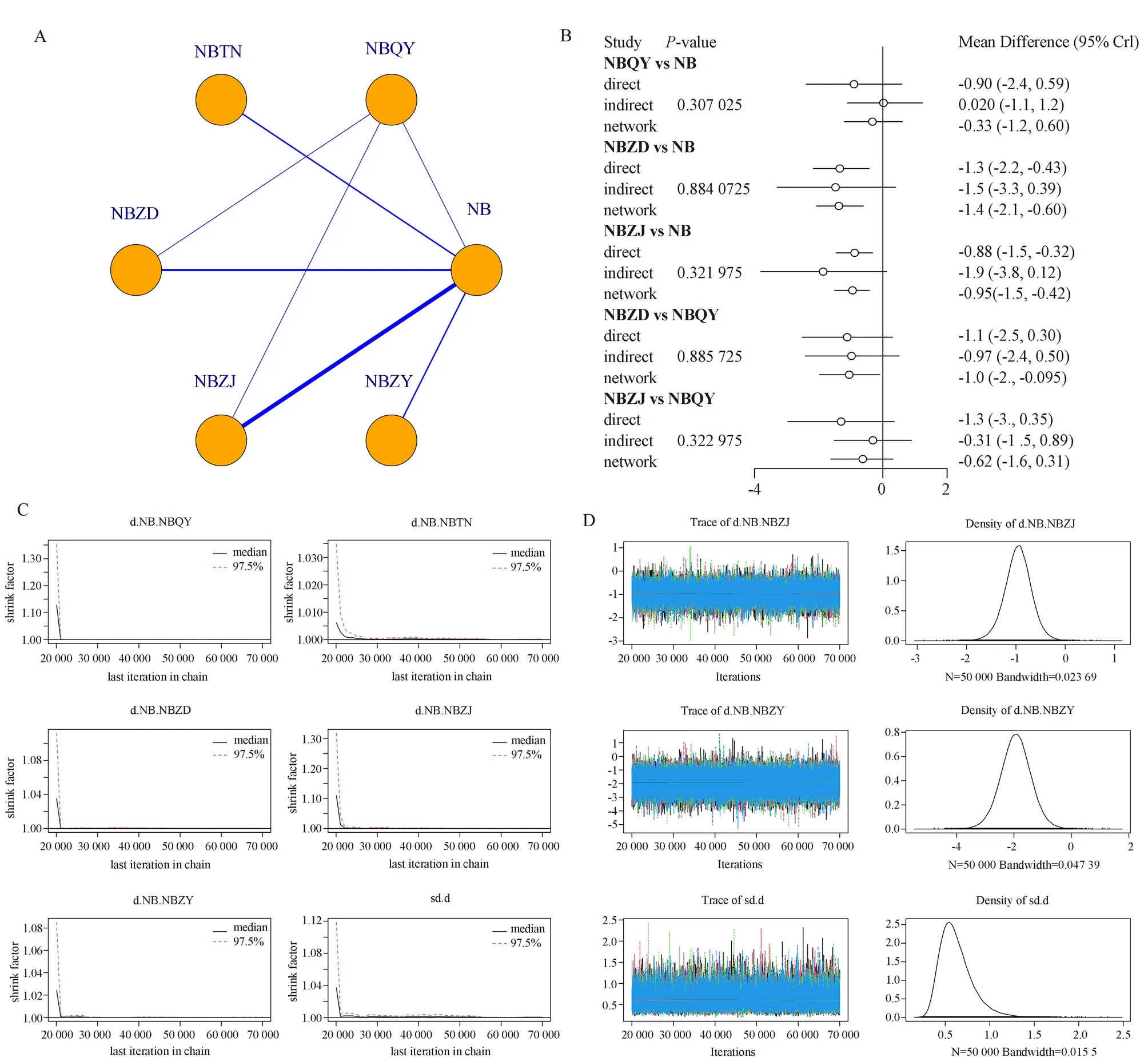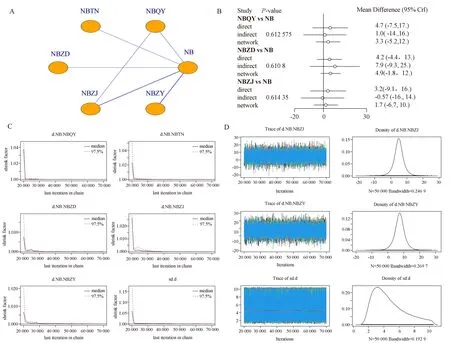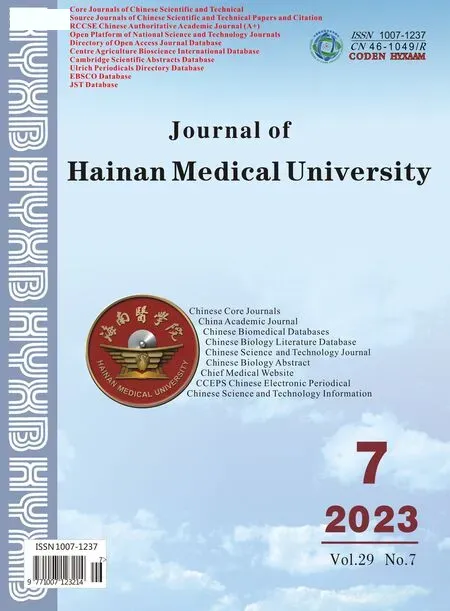Network Meta-analysis of nerve block combined with Chinese medicine for lumbar disc herniation
WANG Xiong-wei, YANG Ke-xin, SUN Kai, LIU Zhi-wei, SUN Wu, WEI Xu, ZHU Li-guo?
1.Beijing University of Chinese Medicine, Beijing 100029, China
2.Wangjing Hospital of China Academy of Traditional Chinese Medical Sciences, Beijing 100102, China
ABSTRACT Objective: To evaluate the clinical efficacy of Chinese medicine methods (acupuncture,tui na, acupuncture knife, traditional Chinese medicine, traction) combined with nerve block treatment for lumbar disc herniation using Bayesian mesh Meta-analysis.Methods:Randomized controlled studies of TCM methods combined with nerve block for lumbar disc herniation in CNKI, Wanfang, Vip, China Biomedical Literature Library, Pubmed,Web of science, and The Cochrance Library databases were searched for the period from the establishment of each database to May 2021.2 researchers independently followed the developed nerf criteria to Screening was performed.Bayesian model mesh Meta-analysis was performed using R, RStudio, and addis-1.16.6 software.Results: Twenty-seven papers with a total of 2074 subjects were finally included, involving six interventions, namely nerve block alone, herbal medicine combined with nerve block, acupuncture combined with nerve block, acupuncture combined with nerve block, traction combined with nerve block, and tui na combined with nerve block.The results of the net analysis showed that (1)in terms of efficiency, all interventions were better than simple nerve block except for traction combined nerve block, and acupuncture, acupuncture, tui-na and Chinese medicine combined nerve block were better than traction combined nerve block respectively, and the probability ranked first for acupuncture combined nerve block.(2) On the VAS score, except for traction combined with nerve block, other interventions were superior to simple nerve block, and the combination of herbal medicine, acupuncture, and acupuncture respectively was superior to traction combined with nerve block, and the intervention with the best probability ranking result was herbal medicine combined with nerve block.(3)There was no statistical difference between the two interventions compared in terms of JOA scores, and the probability ranked first for herbal medicine combined nerve block.Conclusion: Chinese medicine combined nerve block was superior to nerve block alone, and Chinese medicine combined nerve block and acupuncture combined nerve block measures were more effective in the treatment of LDH, and traction combined nerve block was less effective.
Keywords:
Nerve block
Lumbar disc herniation
Chinese medicine
Network Meta-analysis
1.Introduction
Lumbar disc herniation (LDH) is a syndrome with low back pain as the main clinical manifestation, which is a common and frequently-occurring disease in orthopedics and has become one of the public problems that endanger human health[1,2].Nerve block is one of the minimally invasive interventional treatments, which allows drugs to act directly on the lesion site, with the effect of antiinflammation, decongestion, and blunt release of adherent nerve roots, with rapid onset of action, and the symptoms of low back and leg can be significantly relieved in about 10 min of medication, with little trauma and quick recovery, but its long-term efficacy is poor and the recurrence rate is high[3-5].There are more TCM methods for the treatment of LDH, which can benefit most patients to varying degrees, and in combination with nerve blocks, they not only increased the number of cures and reduce recurrence, but are also more acceptable to patients[6,7].The advantages and disadvantages between several TCM approaches combined with nerve blocks for LDH are unclear.Therefore, this network meta-analysis aims to compare the efficacy of acupuncture, tuina, acupuncture knife,Chinese medicine, and traction combined with nerve block for LDH,respectively, in order to provide some clinical reference.
2.Materials and Methods
2.1 Inclusion Criteria
The study type was a clinical randomized controlled study (RCT);the study subjects was clearly diagnosed with lumbar disc herniation;age, sex, disease duration, and TCM subtype were not limited.Interventions in the treatment group were nerve block combined with TCM, including Chinese herbs, acupuncture, acupuncture knife,tuina, and lumbar traction.In the control group, the interventions were nerve block alone or nerve block combined with the rest of Chinese medicine.All interventions were no more than 2 treatment methods.Outcome indicators ①Total effective rate, which was the recent efficacy evaluation; ②VAS score, which was calculated by 10 points; ③JOA score.
2.2 Exclusion Criteria
Uncontrolled case observations, case reports, conferences, reviews,duplicate publications, incomplete or erroneous data, literature for which full text is not available
2.3 Literature Search
The databases were searched by CNKI, WanFang, VIP, SinoMed,Pubmed, Cochrane Library, and Web of Science, and the search method was adjusted according to the characteristics of the respective databases.The search was conducted until May 2021 using the search terms “lumbar disc herniation”, “TCM”, “LDH”,“nerve block”, “acupuncture”, “tuina”, and “small acupuncture”,“traditional Chinese medicine”, “traction”.
2.4 Literature screening and data extraction
The retrieved literature was imported into NoteExpress software for management, and 2 researchers independently screened the literature, first removing duplicates using the software, then reading the title and abstract for screening, and finally acquiring the literature that met the requirements by reading the full text, and in case of disagreement, the third researcher made a decision.Information was extracted from the final included literature and the data was imported into an EXCEL sheet.
2.5 Evaluation of the quality of the included literature
The literature was evaluated according to a manual provided by Cochrance.com.The manual evaluates 7 aspects, (1) choice of randomization method, (2) allocation concealment, (3) blinding of study conductors and subjects, (4) blinding of evaluation of outcomes, (5) completeness of outcome data, (6) selective reporting of study results, and (7) other risks of bias, each with “high risk “,“unclear”, and “low risk”for each aspect.The literature evaluation was performed by 2 investigators, and the third investigator was involved in the joint deliberation on the controversial points.Revman 5.3 software was used for mapping.
2.6 Statistical Analysis
Bayesian model reticulation Meta-analysis was performed using R, RStudio, and addis-1.16.6 software.Direct Meta-analysis was performed using I2to determine the size of heterogeneity, I250%,indicating that the heterogeneity was small and the effects could be combined, and if I2>50%, suggesting greater heterogeneity, further sensitivity analysis was performed.Consistency test: The nodal analysis model was used for consistency test of direct comparison and indirect comparison, and if P>0.05, the consistency model was selected for network meta-analysis, otherwise non-consistency model.The model was simulated using 4 chains with an initial value of 2.5, a step size of 10, and a number of iterations of 50 000, with the first 20 000 used for annealing and from 20 001-50 000 used for sampling.Convergence diagnostic plots and trajectory density plots were used to evaluate the degree of model convergence, combined with the potential scale reduction factor (PSRF), PSRF tends to 1, which indicates satisfactory convergence, and PSRF between 1 and 1.05 indicates reliable model results.OR was used as the effect indicator for effective rate, and MD was used as the effect indicator for VAS score and JOA score, and 95% CI was calculated.95% CI for effective rate contained 1, then the results were not statistically different, and 95% CI for VAS score and JOA score contained 0, then the results were not statistically significant.Probability ranking was performed for several treatment measures.Two-dimensional plots were produced using R to combine the advantages and disadvantages of several interventions in terms of VAS scores and JOA scores.
3.Results
3.1 Literature search results
The major literature databases were searched, and 1 742 pieces of literature were initially obtained, 865 pieces of duplicate literature were removed, 783 pieces of irrelevant literature were removed by reading the titles and abstracts, and finally the full text was downloaded and read to exclude the literature that did not meet the requirements, and 27 pieces of literature were finally included,and all the included literature were in Chinese.The flow chart of literature screening is shown in Figure 1.

3.2 Basic characteristics of the included literature
This study finally included 27 publications[8-34]with a total of 2 074 subjects, including 1040 subjects in the experimental group and 1 034 patients in the control group.A total of 6 interventions were used, namely herbal medicine combined with nerve block[16,20,21,25],tuina combined with nerve block[18,19,23,24,28,32], traction combined with nerve block[13-15], acupuncture knife combined with nerve block[10,13,17,22,27,30], acupuncture combined with nerve block[8,9,11,12,14,26, 29,31,33,34], and nerve block alone.The basic characteristics of the included literature are shown in Table 1.
3.3 Evaluation of the quality of the included literature
All of the included literature mentioned random grouping, of which14 articles[8-12,14,17-20,25,29,32,33] mentioned the use of the random number table method for grouping, 3 articles[13,15,21] randomized by time of admission, and 1 articles[27] distributed random envelopes.The included literature were all unmentioned allocation concealment,no mention of blinded implementation for participants, complete outcome data and no selective reporting.1 article[22] reported case shedding.Other biases were not clear.The quality of the literature is evaluated in Figure 2.

Tab 1 General information extracted from the included literature

Fig 2 Evaluation of the risk of literature bias
3.4 Direct Meta-analysis
In terms of efficiency, acupuncture combined with nerve block(NBZJ), acupuncture knife combined with nerve block (NBZD),tuina combined with nerve block (NBTN), and Chinese herbal medicine combined with nerve block (NBZY) were superior to nerve block alone (NB), and acupuncture knife combined with nerve block (NBZD) was superior to traction combined with nerve block (NBQY).In terms of VAS score, acupuncture combined nerve block (NBZJ), acupuncture knife combined nerve block(NBZD), tuina combined nerve block (NBTN), Chinese herbal medicine combined nerve block (NBZY), traction combined nerve block (NBQY) were better than nerve block (NB), acupuncture combined nerve block (NBZJ) was better than traction combined nerve block (NBQY), acupuncture knife combined nerve block(NBZD) was better than traction combined nerve block (NBQY),acupuncture knife combined nerve block (NBZD) is better than traction combined nerve block (NBQY).Among them, acupuncture knife combined nerve block (NBZD) and herbal combined nerve block (NBZY) were more heterogeneous, and the direction of the outcome was not changed after sensitivity analysis.In terms of JOA scores, acupuncture combined nerve block (NBZJ), acupuncture knife combined nerve block (NBZD), tuina combined nerve block(NBTN), Chinese herbal medicine combined nerve block (NBZY),and traction combined nerve block (NBQY) were superior to nerve block alone (NB), acupuncture combined nerve block (NBZJ) was superior to traction combined nerve block (NBQY), and Chinese herbal medicine combined nerve block (NBZY), and acupuncture combined nerve block (NBZJ) were more heterogeneous, and the direction did not change after sensitivity analysis.The rest of the comparisons were not statistically different.

Tab 3 Results of reticulated Meta-analysis
3.5 Network Meta-analysis
3.5.1 Effective
Network relationship plots: Twenty-four of the included papers reported efficiency, with a total of 1904 subjects, across the six interventions.The reticulated relationship diagram is shown in Figure 3a, the line between two dots indicates a direct comparison of the two interventions, and the width of the line represents the number of direct comparisons.There exist two closed loops NBQYNBZJ- NB and NBQY- NBZD- NB).Consistency tests were performed using nodal analysis for the analysis of interventions that generated closed loops, P>0.05, and the results of direct and indirect comparisons were always selected for consistency model analysis.As shown in Figure 3b.network meta-analysis showed that NBTN,NBZD, NBZJ, and NBZY were superior to NB, NBTN, NBZD,NBZJ, and NBZY were superior to NBQY, and the remaining interventions were not statistically different in comparison.Table 3.the probability ranking of each intervention was: the higher the ranking, the better the effect.NBZJ (46%) > NBTN (30%) > NBZD(33%) > NBZY (31%) > NBQY (47%) > NB (49%).Convergence diagnostic plots as well as trajectory density plots are shown in Figures 3c and 3d.
3.5.2 VAS score

Fig 3 a: Efficient mesh diagram; b: Efficient consistency check chart; c: Diagnostic diagram of efficient convergence; d: Efficient trajectory density map
Of the included studies, 16 papers reported post-treatment VAS scores for a total of 1 168 subjects across six interventions.The network relationship diagram is shown in Figure 4a.The line between two points indicates a direct comparison of the two interventions, and the width of the line represents the number of direct comparisons.There exist two closed loops NBQY- NBZJNB and NBQY- NBZD- NB).Nodal analysis was used for consistency testing, and the interventions that generated closed loops were analyzed with P>0.05, and the results of direct and indirect comparisons were always selected for consistency model analysis.As shown in Figure 4b.net analysis showed that NBTN, NBZD,NBZJ, and NBZY were superior to NB, and NBTN, NBZD, and NBZY were superior to NBQY.the remaining interventions were not statistically different between two comparisons, as shown in Table 3.probability ranking was performed for each intervention: the higher the ranking, the worse the effect.NB (77%) > NBQY (66%) > NBZJ( 68%)>NBZD(52%)>NBTN(43%)>NBZY(57%).Convergence diagnostic plots and trajectory density plots are shown in Figures 4c and 4d.
3.5.3 JOA Score
Of the included studies, eight papers reported post-treatment JOA scores for a total of 673 subjects across six interventions.The network relationship diagram is shown in Figure 5a.where the size of the dots represents the number of subjects, the line between two dots indicates a direct comparison of the two interventions, and the width of the line represents the number of direct comparisons.There exists NBQY- NBZJ- NB a closed loop.Nodal analysis was used for consistency testing, and the analysis of the interventions that generated a closed loop, P>0.05, and the results of direct and indirect comparisons were always selected for consistency model analysis.As shown in Figure 5b.net analysis showed: no statistical difference between two comparisons of each intervention, see Table 3.probability ranking of each intervention: the higher the ranking,the better the effect.nbzy (41%) > nbtn (21%) = nbzj (21%) > nbzd(18%) > nbqy (29%) nb (64%).Convergence diagnostic plots and trajectory density plots are shown in Figures 5c and 5d.

Fig 4 a:VAS score reticulation; b: VAS score consistency test graph; c: Diagnostic chart of VAS score convergence; d: VAS score trajectory density map
3.5.4 Two-dimensional diagram
The results of the VAS score and the JOA score mesh score were integrated with the nerve block as a reference, and the more distributed the lower right side in the planar two-dimensional plot,the better the effect.Figure 6.
3.5.5 Adverse event record
Four papers recorded the occurrence of adverse events, Qu Mei[33] mentioned that no adverse reactions occurred in both groups of acupuncture combined with nerve block against simple nerve block,Gu Dunxing[8] mentioned that 1 case of dizziness, 1 case of limb weakness and 1 case of urinary incontinence in the NBZJ group,with an incidence of 9.38%, and 1 case of dizziness, 1 case of limb weakness and 2 cases of urinary incontinence in the nerve block group, with an incidence of 12.5%.Li Jinheng[14] showed 10 cases of lower limb weakness and 8 cases of subcutaneous bruising in the NBZJ group, with an incidence of 60%, and 9 cases of lower limb weakness in the nerve block group, with an incidence of 30%.Lu Di[17] showed 5 cases of pain aggravation and 2 cases of hematoma in the NBZD group, which was 23%, and 3 cases of pain aggravation in the nerve block group, which was 10%.One literature[27] mentioned 3-month follow-up, and the 3-month follow-up recurrence rate was 4.88% in the NBZD group, and the 3-month recurrence rate of nerve block was 16%.

Fig 5 a: JOA score reticulation; b: JOA score consistency test graph; c:Diagnostic diagram of JOA score convergence; d:JOA score trajectory density map

Tab 2 Results of direct Meta-analysis

Fig 6 Comparison of two-dimensional graphs of VAS scores and JOA scores
4.Discussion
In Chinese medicine, LDH belongs to the category of “low back pain”and “paralysis”.The understanding and treatment of “low back pain”and “paralysis”are well documented in the literature of ancient times.Huangdi Inner Canon: The waist is the house of the kidneys, and the kidneys will be exhausted if they cannot be shaken, QianJingFangs: The kidneys are tied to the waist, because of excessive desire, labor injury to the kidney meridian, the kidneys are deficient, joy, anger and worry, wind, cold and dampness, get to hurt it, so that the waist pain.and also fall and flashing test, Qi condensation and blood stagnation, also cause lumbago, and to the Qing Dynasty and modern literature, lumbago all belong to the room labor kidney deficiency, kidney deficiency, the Governor’s vein must be deficient, is the reason for lumbago, that the disease is based on kidney deficiency.It is believed that this disease is based on kidney deficiency, deficiency of qi and blood combined with external wind, cold and dampness, invading the muscle surface and blocking the meridians, resulting in lumbar constriction,unfavorable movement or fall and injury to localized blood stasis and lumbago.The Treatise on the Origin of Diseases - Lumbago summarizes lumbago into five causes: Shaoyin, wind paralysis,kidney deficiency, fall and injury to the lumbar region, and sleeping on wet ground.Chinese medicine, tuina, acupuncture, acupuncture knife, traction and other measures are all under the guidance of Chinese medicine theory, in the treatment of LDH in the process of continuous practice and innovation, and gradually improve the formation of the characteristics of the therapy, currently widely used in clinical practice, from different angles to treat LDH, each focus, the efficacy of the exact.More and more studies have been conducted to confirm the potential mechanisms of TCM in the treatment of LDH using modern medical methods.Gao Hongwei[35]summarized the understanding of the typology of LDH in TCM through literature review, listed the studies that correspondingly used Chinese medicine group prescriptions for treatment, all of which achieved good clinical efficacy, and further confirmed the mechanism of Chinese medicine for the treatment of lumbar disc herniation from the perspective of modern pharmacology, arguing that Chinese medicine has the effect of regulating human immunity,reducing inflammatory edema, restoring the regulatory function of the human body, and achieving a state of relative equilibrium to cure the disease.Tuina can relieve local muscle tension and restore the balance of muscle strength on both sides of the spine.In addition,Guo Guangxin[36] provided more modern theoretical support for the treatment of LDH with tuina from the immune mechanism.Studies have shown that acupuncture treatment for LDH is mainly related from changing local biomechanics, relieving local nerve injury and improving local microcirculation.Acupuncture therapy has both needle and knife effects, which can loosen adhesions, accelerate inflammation absorption, act directly on the affected area, reduce local pressure, and traction can reduce disc pressure and nerve root compression[37].Traditional Chinese medicine characteristic therapy combined with western medicine nerve block is commonly used in clinical practice for multidimensional treatment of LDH with obvious advantages.However, a comparison between several TCM characteristic therapies combined with nerve block protocols for the treatment of LDH has not been seen, which brings some troubles to the clinical development of treatment protocols; therefore, this study ranked the advantages and disadvantages of several treatment protocols in terms of different outcome indicators in order to provide some reference for the selection of clinical protocols.
This study finally included 27 papers with a total of 2074 subjects,including 1040 subjects in the experimental group and 1034 patients in the control group, and evaluated the combination of Chinese medical treatment with nerve block for LDH in three aspects:efficiency, VAS score and JOA score, respectively.direct Metaanalysis showed that in terms of efficiency, except for traction combined with nerve block, the remaining Chinese medical treatment measures combined with nerve In terms of pain relief, all five Chinese medical treatments combined with nerve block were better than nerve block alone, and acupuncture and acupuncture knife combined with nerve block were better than traction combined with nerve block respectively.In terms of JOA score, all five Chinese medical methods combined with nerve block were better than simple nerve block, and acupuncture combined with nerve block was better than traction combined with nerve block.Bayesian network meta-analysis showed that in terms of efficiency, acupuncture knife combined nerve block, acupuncture combined nerve block, Chinese herbal medicine combined nerve block, and tuina combined nerve block were superior to simple nerve block; tuina combined nerve block, acupuncture combined nerve block, acupuncture combined nerve block, acupuncture combined nerve block, and Chinese herbal medicine combined nerve block were superior to traction combined nerve block.The results of direct Meta-analysis and indirect Metaanalysis were consistent.In terms of efficiency, acupuncture combined with nerve block ranked first.In terms of VAS scores,tuina combined nerve block, acupuncture knife combined nerve block, acupuncture combined nerve block, and Chinese herbal medicine combined nerve block were superior to simple nerve block, and tuina combined nerve block, acupuncture knife combined nerve block, acupuncture combined nerve block, and Chinese herbal medicine combined nerve block were superior to traction combined nerve block, which was consistent with the results of direct Metaanalysis, and the best ranked was Chinese herbal medicine combined nerve block.In terms of JOA scores, there was no statistical difference between the two comparisons of each intervention.The first ranked intervention was herbal combined nerve block.The combined results showed that Chinese herbal medicine combined with nerve block and acupuncture combined with nerve block were more effective in the treatment of LDH, and traction combined with nerve block was less effective.
The shortcomings of this study, (1) the literature included in this study were all in Chinese, and all trials were conducted in China, so there may be some geographical bias; (2) the quality of the included literature were not high, and the allocation of concealment and the implementation of blinded method were not mentioned; (3) among the interventions, there were differences in the frequency, intensity,and duration of treatment, and acupuncture had different operators,selection of acupuncture points, retention time, and execution of acupuncture, etc.In the Chinese medicine treatment In the Chinese herbal medicine treatment, there was no further grouping analysis of the patients’evidence, and there were differences in the oral and external use of Chinese herbal medicine, which to some extent may lead to heterogeneity; (4) the time point of the outcome was not unified, which may lead to some differences in the combined results;(5)all the included studies were conducted for long-term followup.Further studies are needed regarding the long-term efficacy of Chinese medicine combined with nerve block in the treatment of LDH.Therefore, large sample, multicenter, high-quality clinical randomized controlled studies are still needed in the later stage.
In conclusion, Chinese medical measures such as acupuncture,tuina, Chinese herbal medicine, and acupuncture combined with nerve block can improve the efficiency of LDH, relieve pain, and improve lumbar spine function scores.Chinese medicine combined with nerve block and acupuncture combined with nerve block measures were more effective in the treatment of LDH, and traction combined with nerve block was less effective.However, due to the low quality of the included literature, there may be potential risks,and it is still necessary to identify and treat patients according to their specific conditions and develop individualized treatment plans in clinical practice to improve clinical efficacy.
(Acknowledgments: Wang Xiongwei was responsible for the study design, implementation, literature search, data extraction,data analysis, paper writing, and revision.Zhu Liguo and Yang Kexin were responsible for topic selection guidance, article writing guidance, and research funding support.Wei Xu and Sun Wu are responsible for technical support and guidance during implementation.Liu Zhiwei is responsible for literature search and data extraction.Sun Kai is responsible for assisting as a third party to solve problems when disputes arise in the process of literature screening and data extraction)
 Journal of Hainan Medical College2023年7期
Journal of Hainan Medical College2023年7期
- Journal of Hainan Medical College的其它文章
- Ethanol extract of Annona muricata Linn fruit perform antidiabetic effect on type 2 diabetic mice through α-glucosidase inhibition
- HPLC fingerprint of Nauclea officinalis stems in different harvesting period
- Effect of Tebuconazole exposure on oral Atenolol absorption in rats,based on bile acid homeostasis
- Efficacy evaluation of Shenlan oral liquid in the treatment of experimental thrombosis and hyperlipidemia
- Effect of Qingjin Huatan Decoction on transferrin and Iron regulatory protein in COPD rats
- Electroacupuncture on hippocampal CREB/BDNF/TrkB in depressive rats effects of signaling pathways
